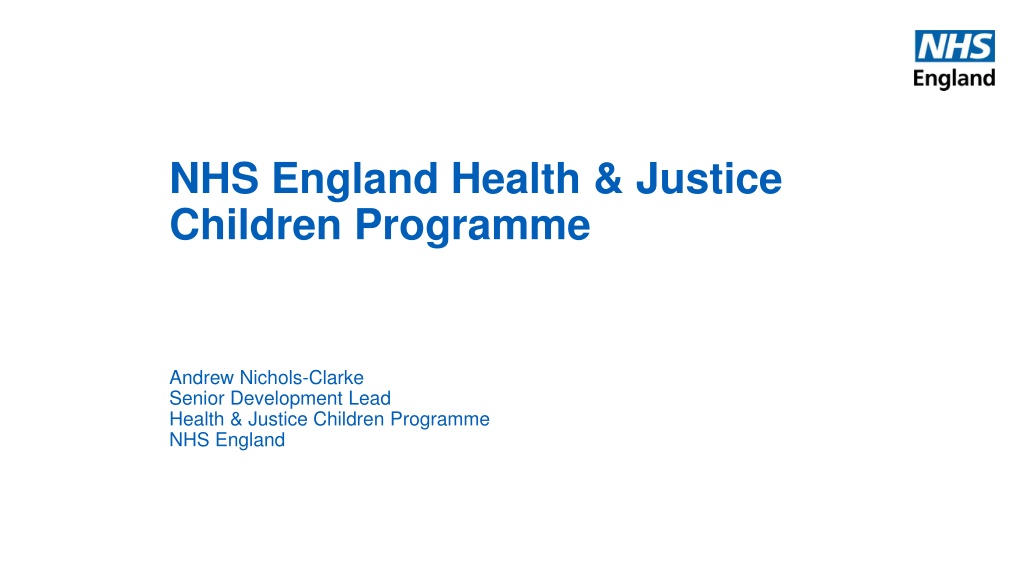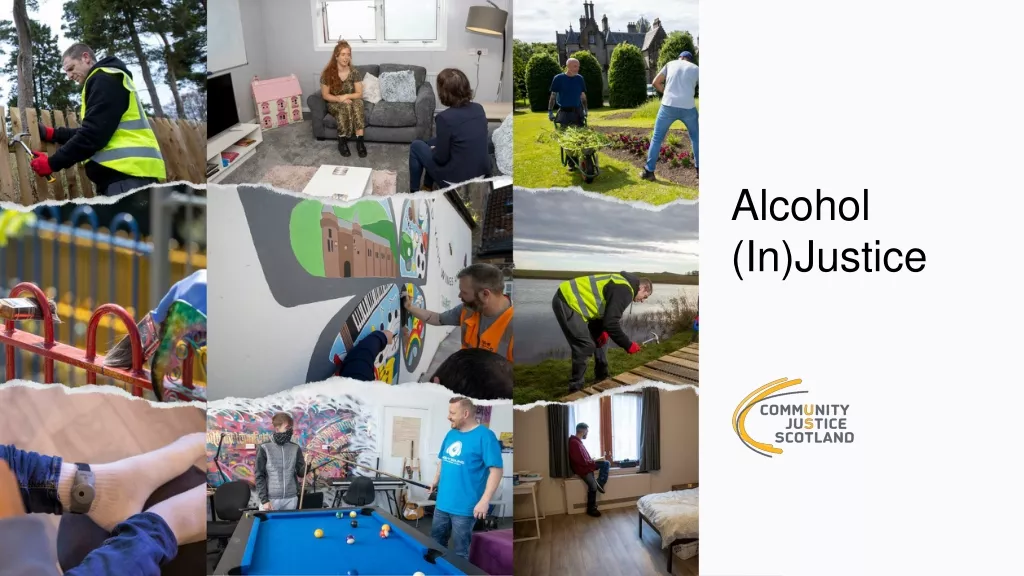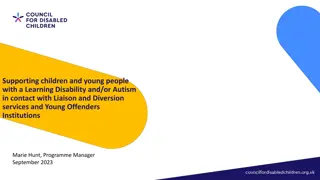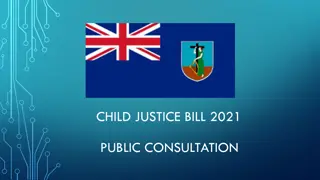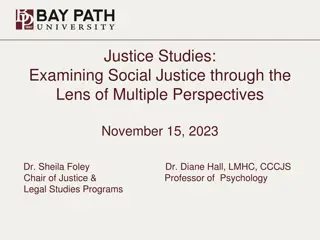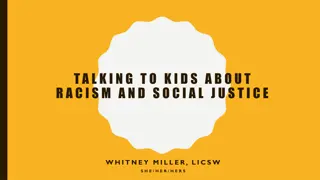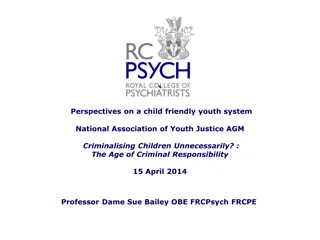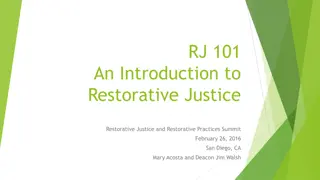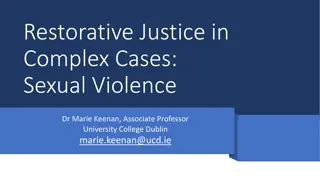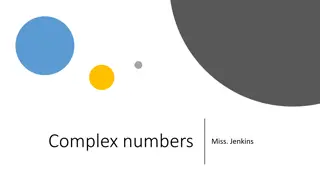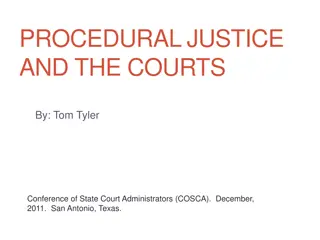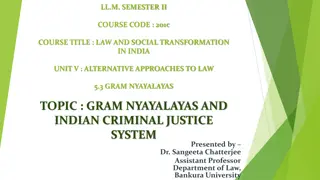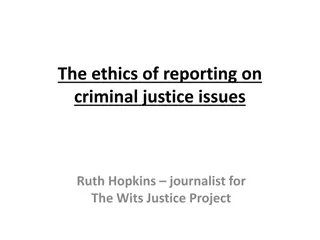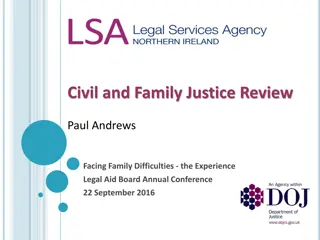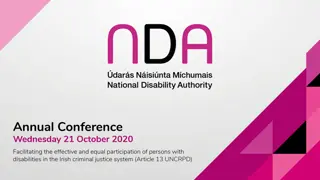Understanding Complex Needs of Children in Justice System
Children with complex needs in the justice system often face high risks and vulnerabilities due to experiences such as adverse childhood events and trauma. This cohort of children has unmet, multi-layered needs and struggles with social disadvantages, secure attachments, and accessing timely services. The data reveals high rates of mental health concerns, learning disabilities, substance misuse, and lack of engagement in education among these children. Placement in secure settings is often a response to their vulnerabilities, with different legal frameworks governing their care in England.
Download Presentation

Please find below an Image/Link to download the presentation.
The content on the website is provided AS IS for your information and personal use only. It may not be sold, licensed, or shared on other websites without obtaining consent from the author. Download presentation by click this link. If you encounter any issues during the download, it is possible that the publisher has removed the file from their server.
E N D
Presentation Transcript
NHS England Health & Justice Children Programme Andrew Nichols-Clarke Senior Development Lead Health & Justice Children Programme NHS England
Our cohort: children with complex needs This cohort of children often have complex needs in multiple domains and are sometimes described as high risk, high harm, high vulnerability . They may: Have a higher likelihood of having been subjected to Adverse Childhood Experiences (ACEs) Have a higher likelihood of having been subjected to trauma or severe neglect. Not be accessing services in a timely manner in the first place, despite high levels of need. Have experienced high levels of social disadvantage. Have multi- layered, unmet and complex needs. Have challenges in developing secure attachments. 2 | * P 51 NHS Long Term Plan Para 3.29
Children and young people with complex needs The below data is from children on justice placements, however indicated by the 2018 review into young people s secure care, despite the notional clarity of the three components of secure care, children placed in all three types of secure setting often shared similar, disadvantaged backgrounds and characteristics, including mental health difficulties Mental health: Athird (33%) of children in custody were recorded as having mental health concerns, with a higher proportion for girls (41% compared to 33% of boys). 2009 2019 Education: Over 60% were not engaged in education prior to entering custody. Custodial sentences of over 12 months 20% 35% Learning disability: A third (32%) were recorded as having a learning disability or difficulty (compared to 18% in the general population). Violence against the person offences 16% 23% Substance misuse: 45% were recorded as having substance misuse concerns. 19% Remand custodial population 28% Looked after children: 49% were recorded as currently being or having previously been a looked-after-child. [Figures based on analysis looking at new admissions to custody between April 2014 March 2016.] Data Source: Key Characteristics of admissions to youth custody (2017); Criminal Justice System Statistics Quarterly: December 2019; 2011 census; Assessing the needs of sentenced children in the YJS 2018/19 4 |
Children with complex needs Because of their vulnerability and high level of health inequalities this cohort of young people are often placed in a secure setting (deprivation of liberty) as a result of their behaviours and what has happened to them. Children can be deprived of their liberty in England under one of three legal frameworks: Section 25 of the Children Act (1989) placing them in a secure children s home; Under the Youth Justice System on remand or serving a sentence in a secure children s home (SCH), secure training centre (STC) or young offender institution (YOI); The Mental Health Act (1983, as amended 2007) placing them in hospital. Placement in the children and young people secure estate is temporary, and part of a broader pathway of care. The Framework for Integrated Care (Community)* considers the needs of those who are at risk of entering the welfare, youth justice or mental health inpatient estate. It focuses on services working together in a more integrated way, and intervening early to best meet and deliver the needs of children with the most complex needs. 5 |
Voluntary Sector Services Education Physical Health Services Mental Health Services Services often working with this cohort of children Police Social Care Liaison & Diversion Services Youth Offending Teams Local Authority 6 |
How do we work better with these children to support their needs and help them to thrive. 7 |
Changing the Fundamental Question Its not what s wrong with them? (& Us) Its what has happened to them? (& Us) When we truly understand the story, everything becomes understandable 9 |
Education Voluntary Sector Services Physical Health Services Services working better with this cohort of children Mental Health Services Police Liaison & Diversion Services Social Care Youth Offending Teams Local Authority 11 |
Framework for Integrated Care: a system approach TheFramework for Integrated Care provides a set of guiding principles and practices, that act as a template for genuine co-production and development of integrated services for children and young people with complex needs; It represents a shift in ideology, moving away from approaches that seek to fix what is wrong with you to approaches that seek to understand and address what has happened to you ; The Frameworks, both SECURE STAIRS and Community, aim to provide a scaffold for innovative working practices and collaborations across systems and partners to enhance services that seek to prevent re-traumatisation and enable children and young people, with complex needs, to thrive; 12 |
The Framework for Integrated Care (Community) - Principles 2. Children & young people and the relationships they experience are at the centre of all care they receive through genuine co- production. 1. Every Interaction Matters: There is a focus first on building and supporting positive collaborative relationships. 3. Those spending most time with young people are the primary facilitators of change. 5. All behaviour is understandable in context; there is a focus on developing an understanding of each children & young people's behaviours and needs based on their story (Formulation). 6. There is a commitment by all to build and sustain trauma informed organisations. 4. Positively influencing the day to day care is the basis of any intervention and the primary focus of support. 13 |
https://www.england.nhs.uk/wp-content/uploads/2022/05/integrated-care-boards-map-may-2022-v1.2.pdfhttps://www.england.nhs.uk/wp-content/uploads/2022/05/integrated-care-boards-map-may-2022-v1.2.pdf 14 |
Framework for Integrated Care (Community): vanguards by region and Integrated Care Board (ICB) London 15 |
A framework for greater collaboration, heath promotion and use of physical activity and sport across the welfare and justice systems.
The agreement focuses on the use of physical activity and sport across the following five areas: 1. Early Intervention Preventing harm, improving mental health and emotional wellbeing and ensuring that children, young people and adults receive the help they need to thrive. 2. Prevention and diversion Increasing targeted activities and wraparound support to reduce entrants into the youth and adult secure estates. 3. Non-custodial sentences Prioritising health and wellbeing to prevent further offending and supporting the welfare of children, young people and adults. 4. Custody Increasing health and wellbeing-related purposeful activity, skills and opportunities that, where possible, can be continued on release into the community. 5. Continuity of care Supporting social inclusion, recovery from substance misuse, improved physical and mental health and desistance from crime. 17 |
Thank you for listening Any Questions? Andrew.nichols-clarke@nhs.net 18 |
